CHEVROLET BLAZER 1996 2.G Workshop Manual
Manufacturer: CHEVROLET, Model Year: 1996, Model line: BLAZER, Model: CHEVROLET BLAZER 1996 2.GPages: 392, PDF Size: 20.35 MB
Page 51 of 392
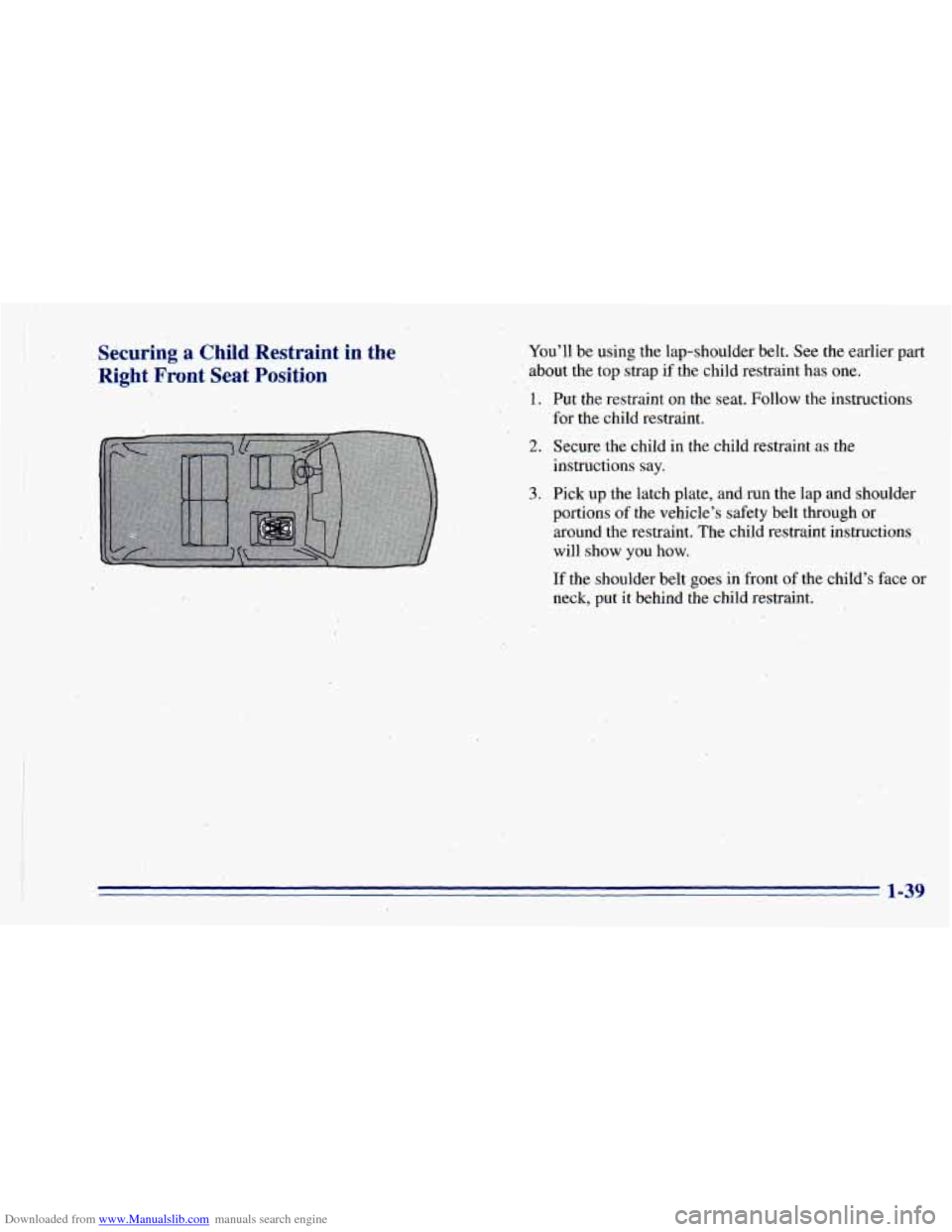
Downloaded from www.Manualslib.com manuals search engine Securing a Child Restraint in the
Right Front Seat Position
You'll be using the lap-shoulder belt. See the earlier part
about the top strap if the child restraint has one.
1.
2.
3.
Put the restraint on the seat. Follow the instructions
for the child restraint.
Secure the child in the. child restraint as the
instructions
say.
Pick up the latch plate, and,run the lap and shoulder
portions of
the vehicle's safety belt through or
around the restraint. The child restraint instructions
will show
you how.
If the shoulder belt goes in front of the child's face or
neck, put it behind the child restraint.
1-39
Page 52 of 392
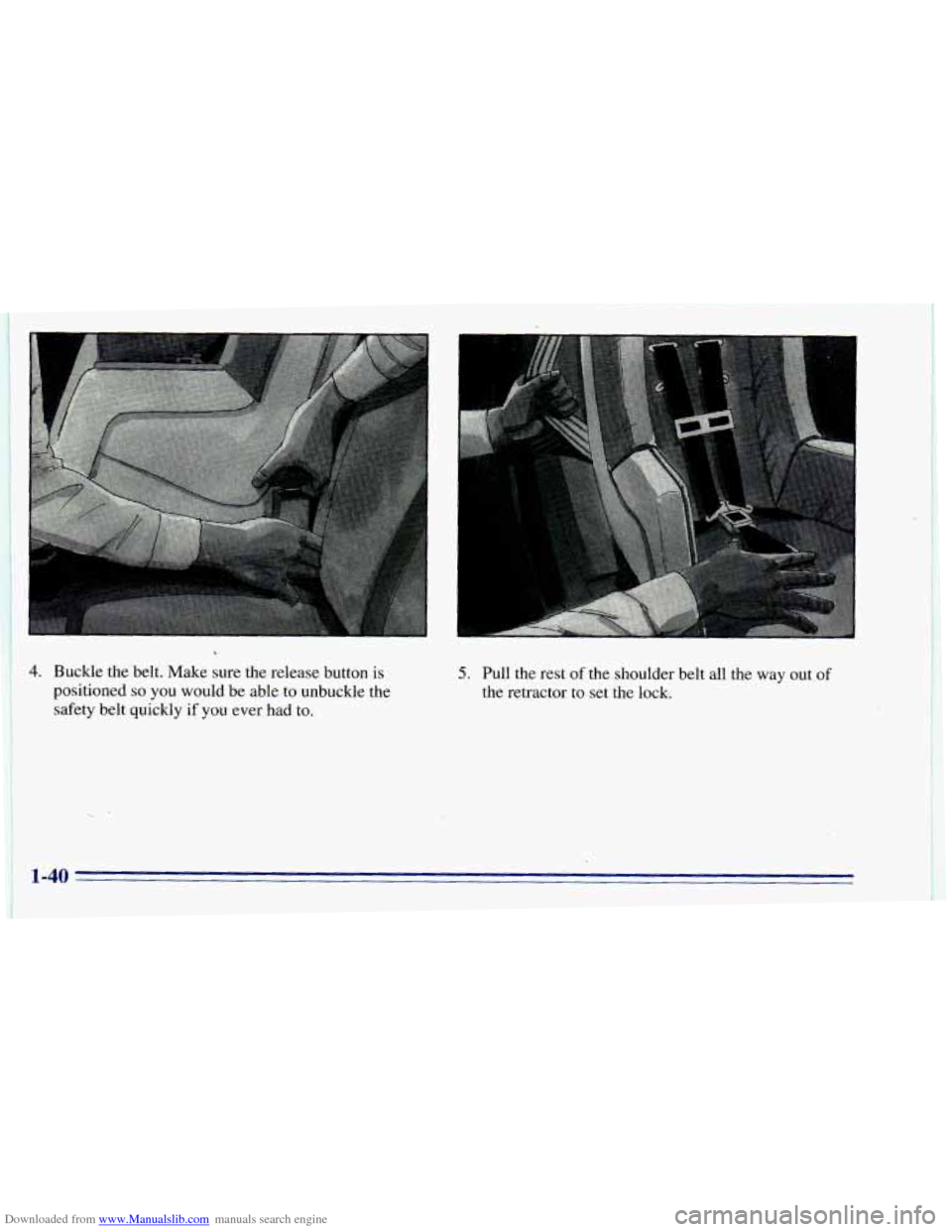
Downloaded from www.Manualslib.com manuals search engine i b
j 4. Buckle the belt. Make sure the release button is 5. Pull the rest of the shoulder belt all the way out of
positioned so you would be able to unbuckle the the retractor to set the lock,.
safety belt quickly if
you ever had to.
1-40
Page 53 of 392
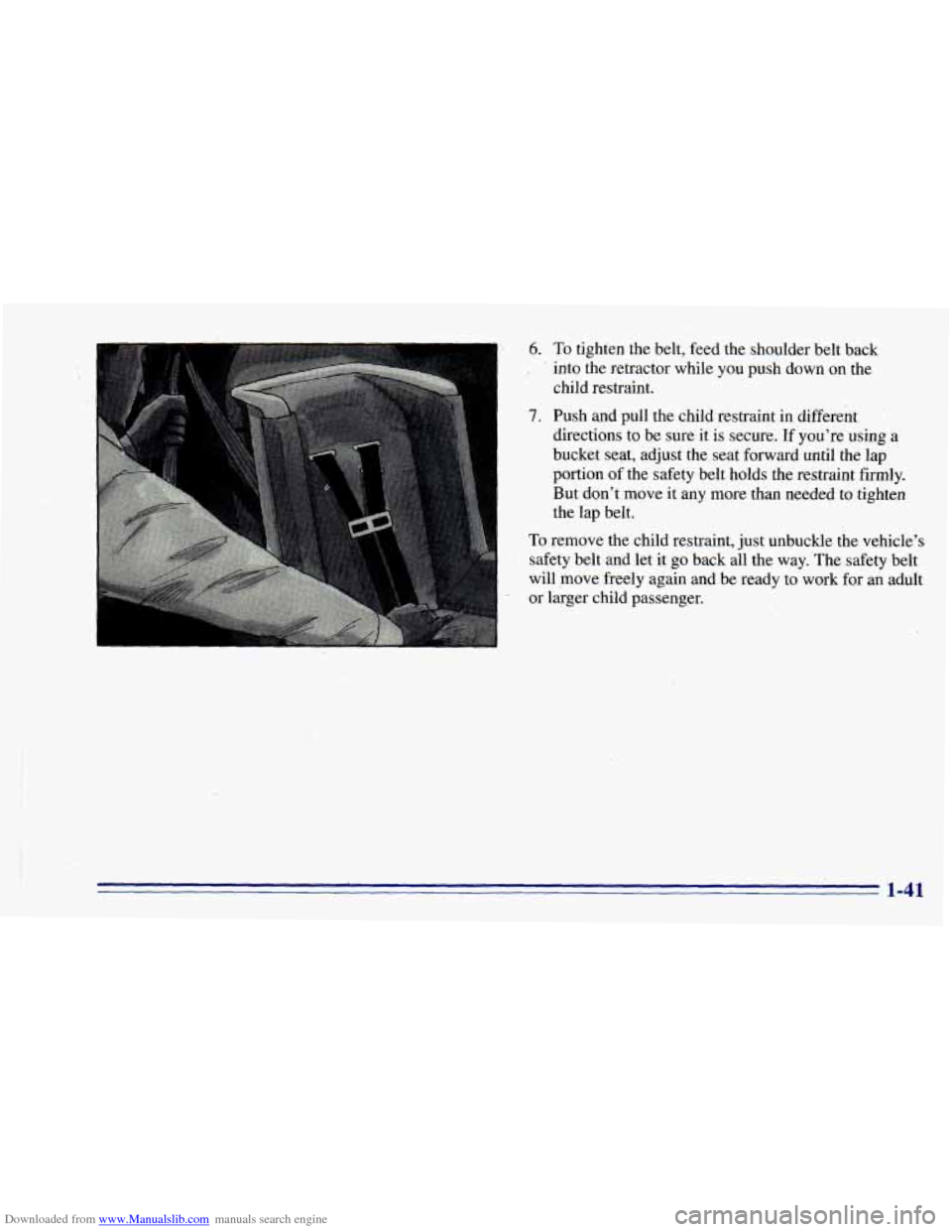
Downloaded from www.Manualslib.com manuals search engine 1 6. To tighten the belt, feed the. shoulder belt back
, ’ into the retractor while you push down on the
7. Push and pull the child restraint in different
I
child restraint.
directions to be sure it is secure. If you’re using a
bucket seat, adj.ust the seat forward until the lap
portion of the safety belt holds the restraint firmly.
But don’t move it any more
than needed to tighten
the lap belt.
To remove the child restraint, just unbuckle the vehicle’s
safety belt and let it go back all the way. The safety belt
will move. freely again and be ready to work for an adult
- or larger child passenger.
1-41
Page 54 of 392
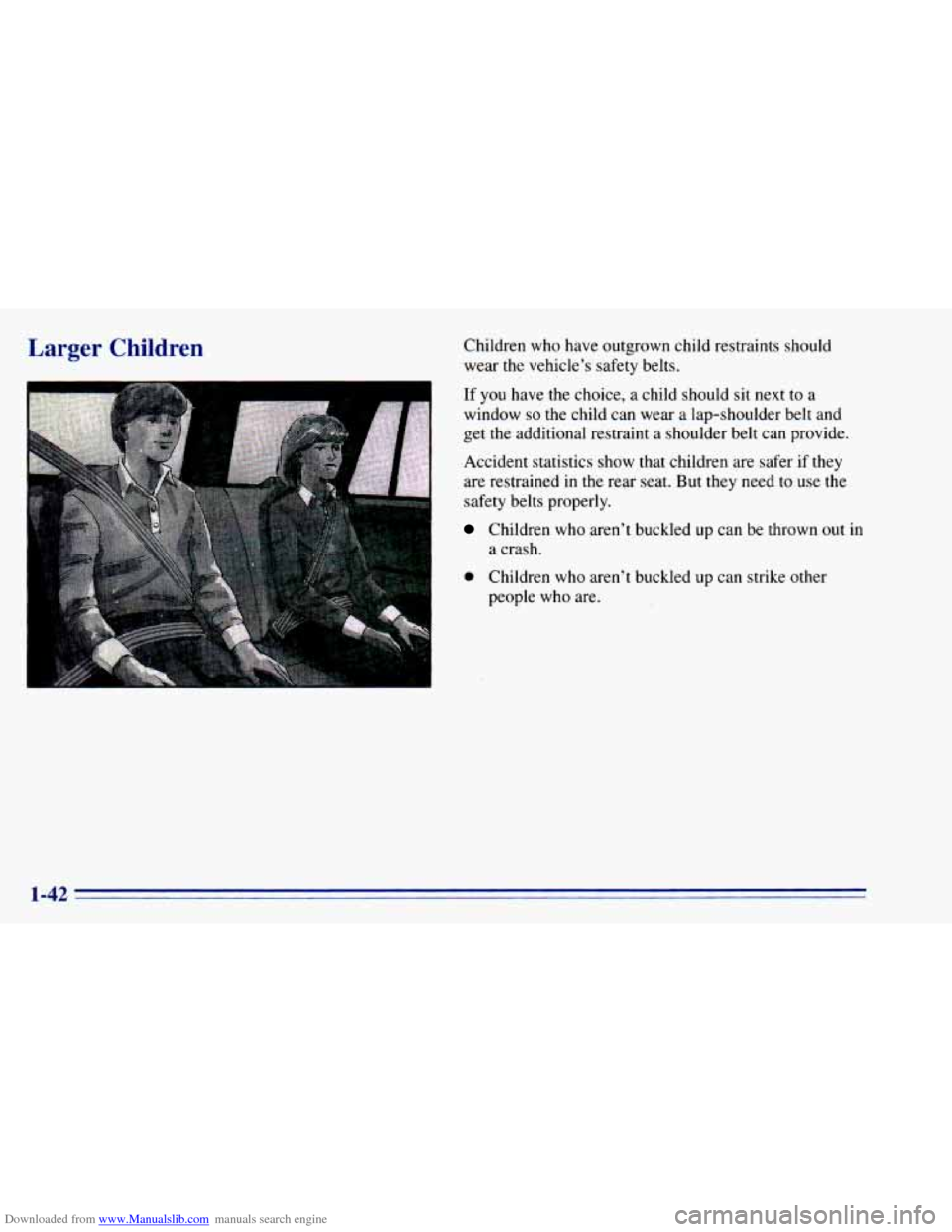
Downloaded from www.Manualslib.com manuals search engine Larger Children Children who have outgrown child restraints should
wear the vehicle's safety belts.
If you have the choice, a child should sit next to a
window
so the child can wear a lap-shoulder belt and
get
the additional restraint a shoulder belt can provide.
Accident statistics show that children are safer if
they
are restrained in the rear seat. But they need to use the
safety belts properly.
Children who aren't buckled up can be thrown out in
a crash.
0 Children who aren't buckled up can strike other
people who are.
1-42
Page 55 of 392
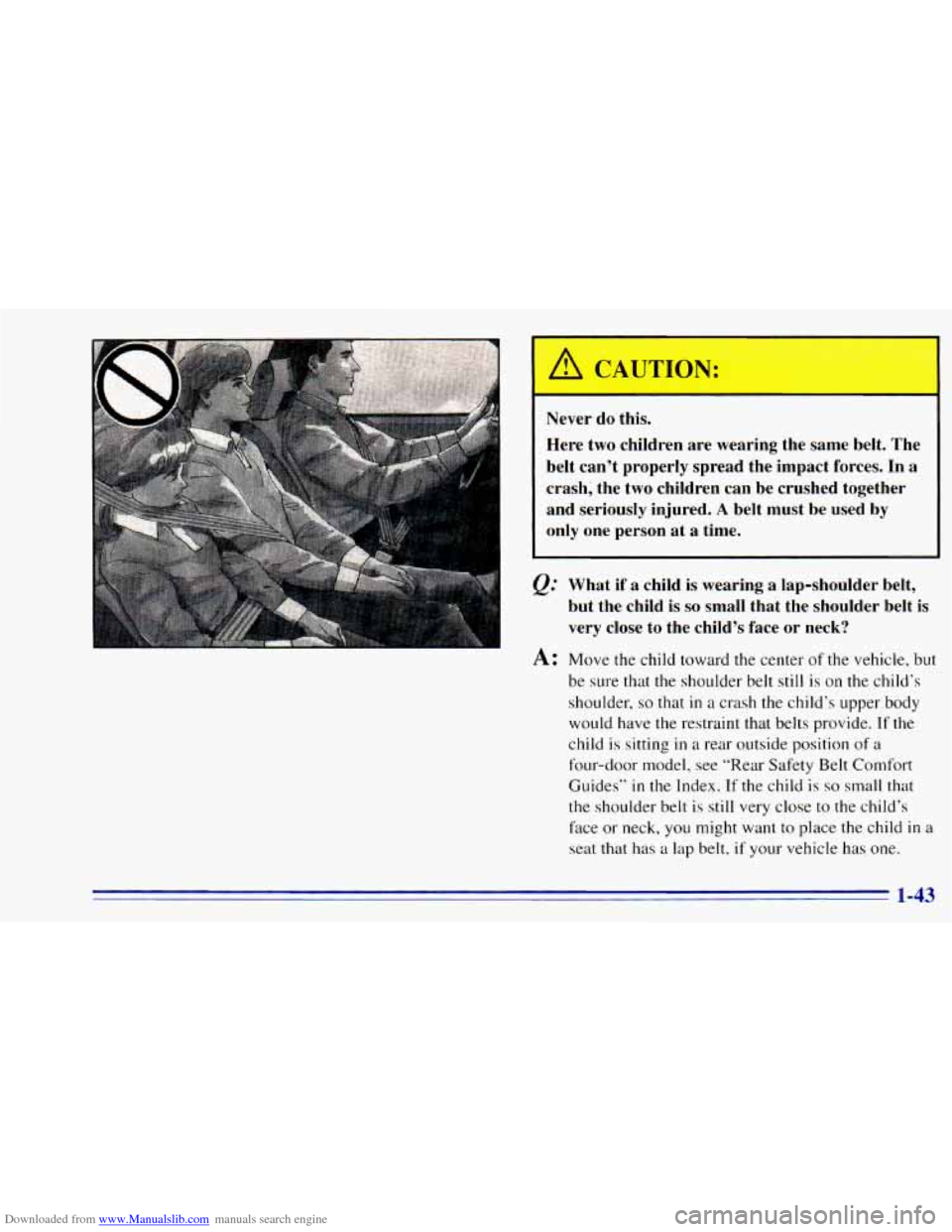
Downloaded from www.Manualslib.com manuals search engine ;his.
Here two children are wearing the same belt. The
belt can’t properly spread the impact forces. In
a
crash; the two children can be crushed together
and seriously injured.
A belt must be used by
only one person at a time.
&: What if a child is wearing a lap-shoulder belt,
but the child is
so small that the shoulder belt is
very close to the child’s face or neck?
A: Move the child toward the center of the vehicle, but
be sure that
the shoulder belt still is on the child’s
shoulder,
so that in a crash the child’s upper body
would have the restraint that belts provide.
If the
child is sitting
in a rear outside position of a
four-door model, see “Rear Safety Belt Comfort
Guides”
in the Index. If the child is so small that
the shoulder belt is still very close to the child’s
face or neck,
you might want to place the child in a
seat that has a lap belt,
if your vehicle has one.
1-43
Page 56 of 392
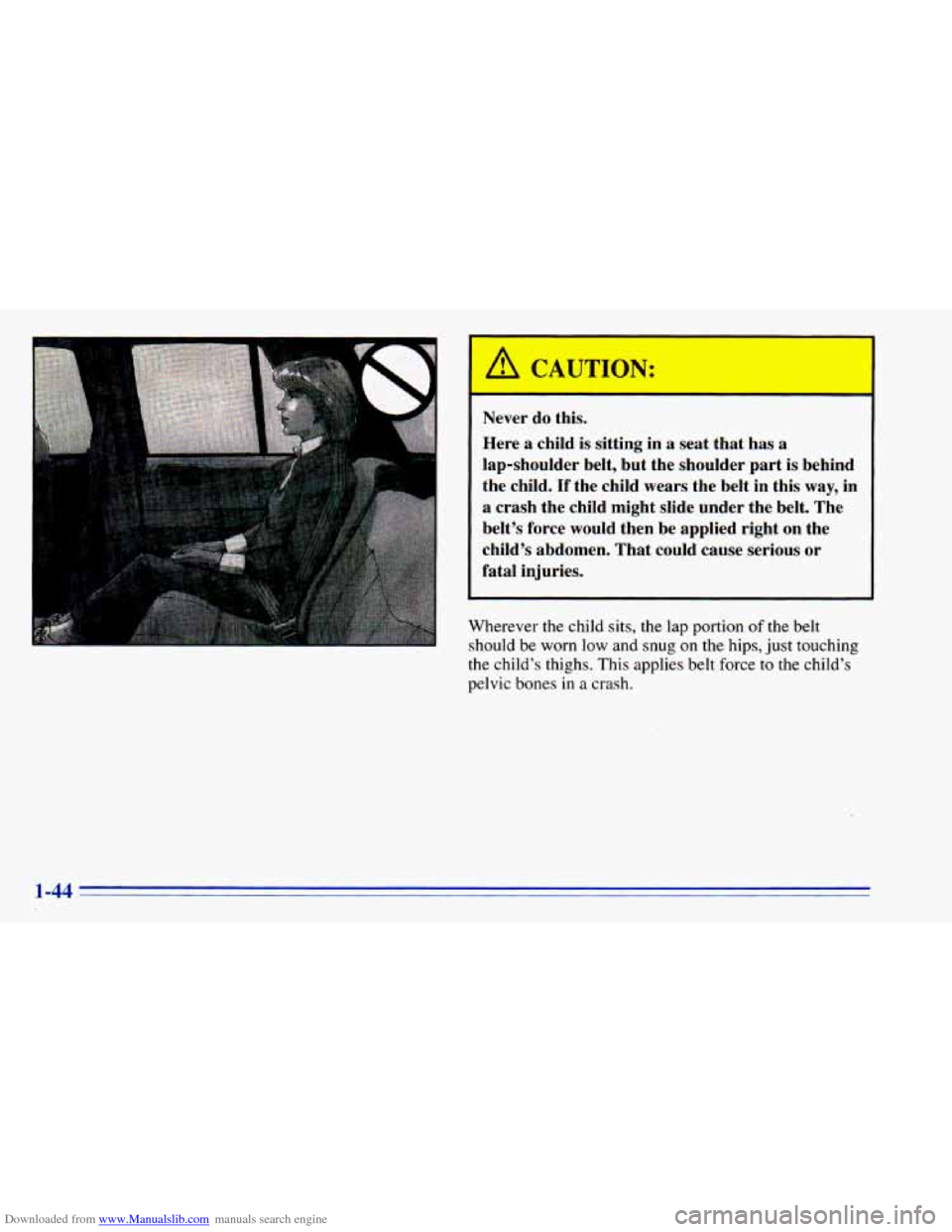
Downloaded from www.Manualslib.com manuals search engine A CAUTION:
Never do this.
Here a child is sitting in
a seat that has a
lap-shoulder belt, but the shoulder part
is behind
the child. If the child wears the belt in this way, in
a crash the child might slide under the belt. The
belt’s force would then be applied right
on the
child’s abdomen. That could cause serious or
fatal injuries.
Wherever the child sits, the lap portion
of the belt
should be worn low and snug on the hips, just touching
the child’s thighs. This applies belt force
to the child’s
pelvic bones in a crash.
1 -44
Page 57 of 392
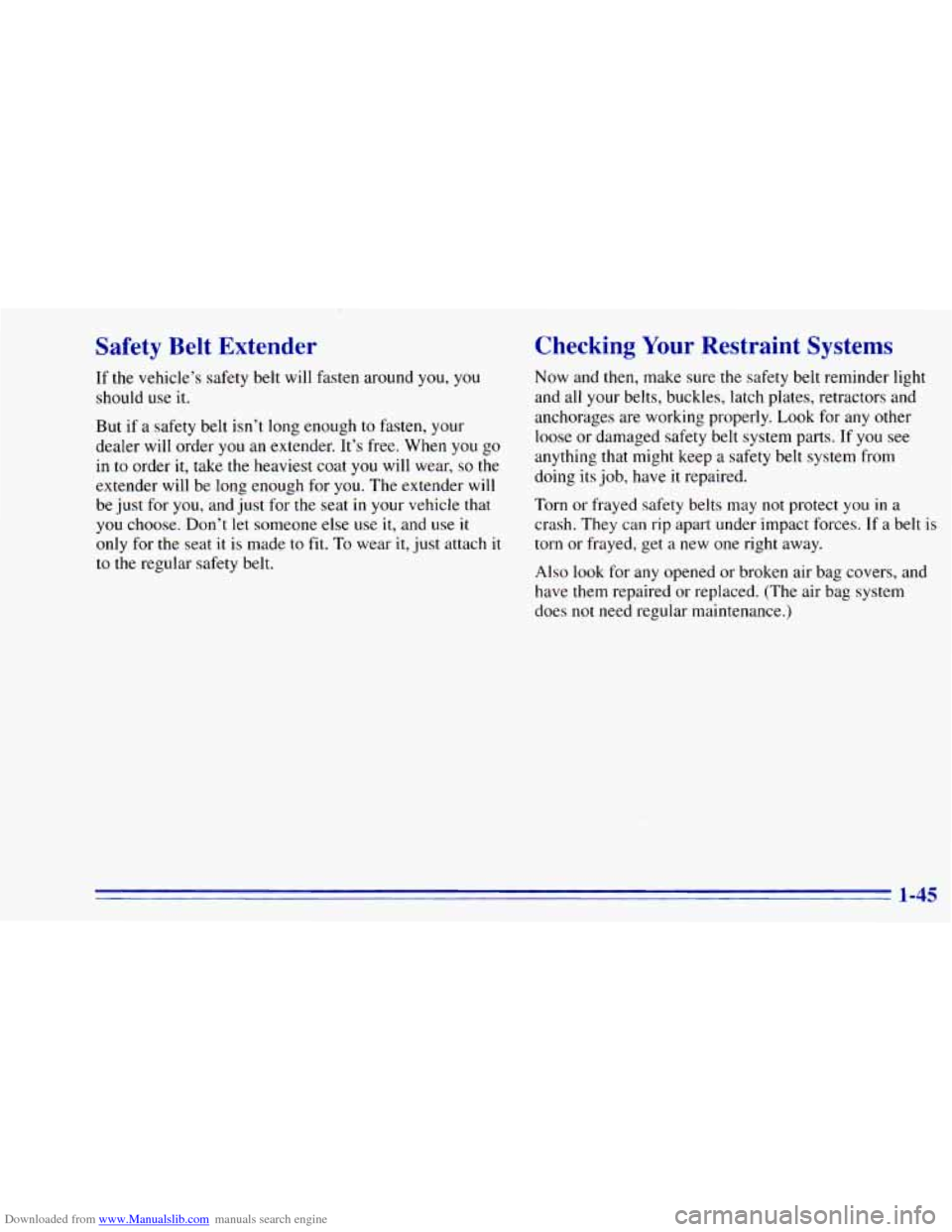
Downloaded from www.Manualslib.com manuals search engine Safety Belt Extender
If the vehicle’s safety belt will fasten around you, you
should use
it.
But if a safety belt isn’t long enough to fasten, your
dealer will order
you an extender. It’s free. When you go
in to order it, take the heaviest coat
you will wear, so the
extender will be long enough for
you. The extender will
be just for you, and just for the seat in your vehicle that
you choose. Don’t let someone else use it, and use it
only for the seat it is made to fit. To wear it, just attach it
to the regular safety belt.
Checking Your Restraint Systems
Now and then, make sure the safety belt reminder light
and all your belts, buckles, latch plates, retractors and
anchorages are working properly.
Look for any other
loose or damaged safety belt system parts. If
you see
anything that might keep
a safety belt system from
doing its
job, have it repaired.
Torn or frayed safety belts may not protect you
in a
crash. They can rip apart under impact forces.
If a belt is
torn or frayed, get a new one right away.
Also look for any opened or broken air bag covers, and
have
them repaired or replaced. (The air bag system
does not need regular maintenance.)
1-45
Page 58 of 392
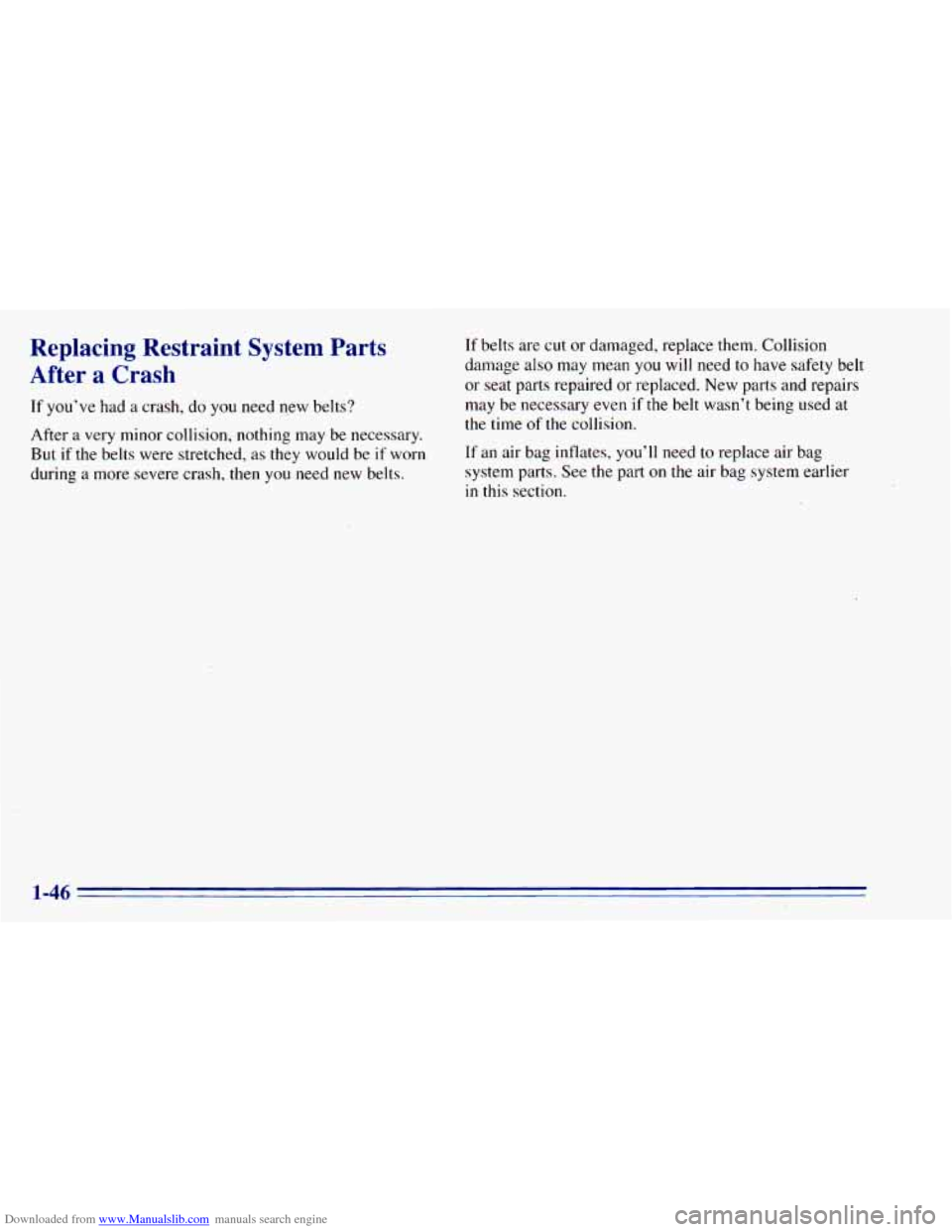
Downloaded from www.Manualslib.com manuals search engine Replacing Restraint System Parts
After
a Crash
If you’ve had a crash, do you need new belts?
After
a very minor collision, nothing may be necessary.
But if the belts were stretched,
as they would be if worn
during
a more severe crash, then you need new belts. If
belts are cut or damaged, replace them. Collision
damage
also may mean you will need to have safety belt
or seat parts repaired or replaced. New parts and repairs
may be necessary even
if the belt wasn’t being used at
the time of the collision.
If an air bag inflates, you’ll need to replace air bag
system parts. See the part
on the air bag system earlier
in this section.
1-46
Page 59 of 392
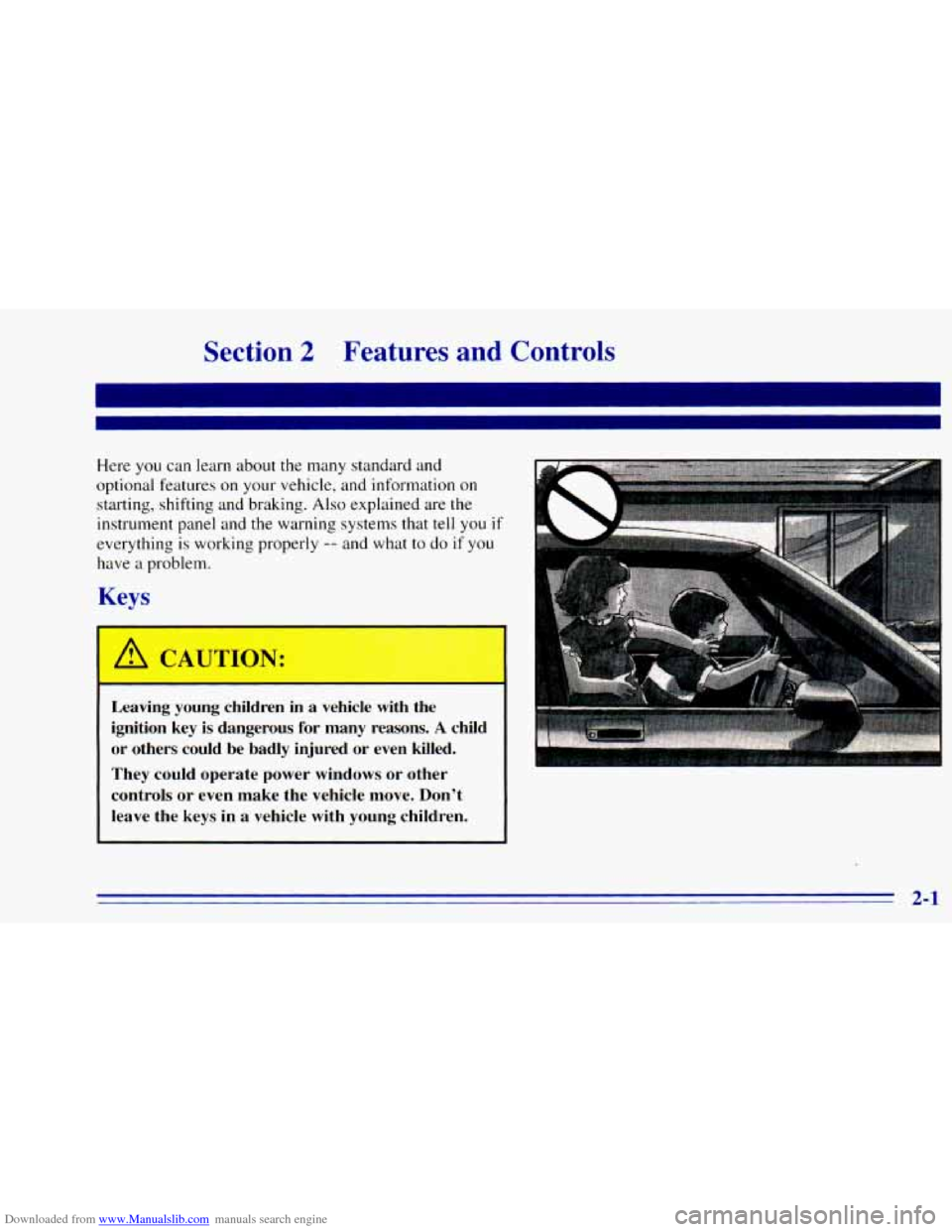
Downloaded from www.Manualslib.com manuals search engine Section 2 Features and Controls
1
I
Here you can learn about the many standard and
optional features
on your vehicle, and information on
starting, shifting and braking. Also explained are the
instrument panel and the warning systems that
tell you if
everything
is working properly -- and what to do if you
have
a problem.
Keys
A CAUTION:
!n in a VI !W the
Lea lg youni
ignition key is dangerous for many reasons.
A child
or others could be badly injured or even killed.
They could operate power windows
or other
controls or even make the vehicle move. Don't
leave the keys in
a vehicle with young children.
2- 1
Page 60 of 392
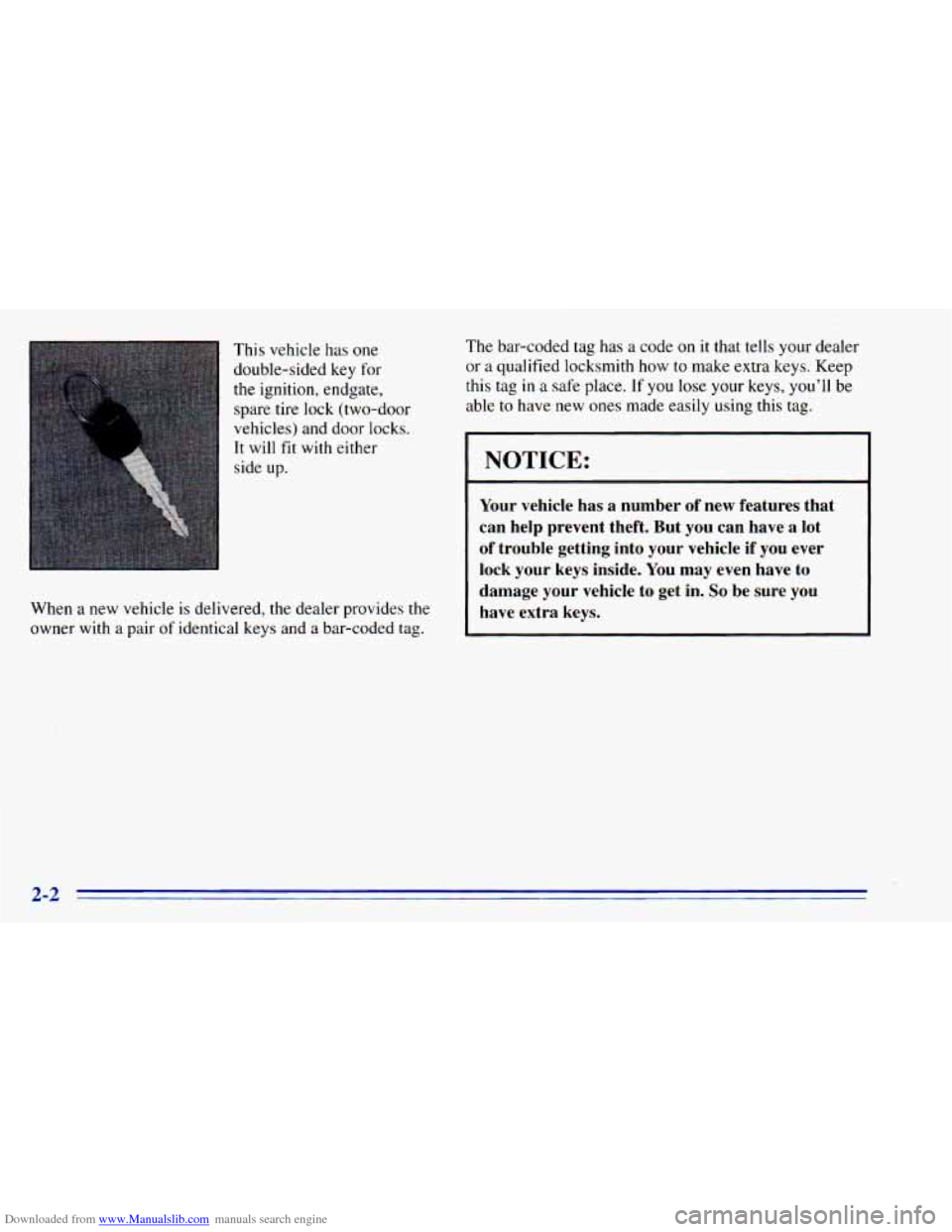
Downloaded from www.Manualslib.com manuals search engine . This vehicle has one
double-sided key for
the ignition, endgate,
spare tire lock (two-door
vehicles) and door locks.
side up.
1 It will fit with either
When a new vehicle is delivered, the dealer provides the
owner with a pair
of identical keys and a bar-coded tag.
The bar-coded tag has a code on it that tells your dealer
or a qualified locksmith how to make extra keys. Keep
this tag
in a safe place. If you lose your keys, you’ll be
able to have new ones made easily using this tag.
I NOTICE:
Your vehicle has a number of new features that
can help prevent theft. But you can have a lot
of trouble getting into your vehicle if you ever
lock your keys inside.
You may even have to
damage your vehicle to get in.
So be sure you
have extra keys.
2-2